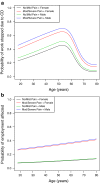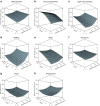Cervical dystonia and pain: characteristics and treatment patterns from CD PROBE (Cervical Dystonia Patient Registry for Observation of OnabotulinumtoxinA Efficacy)
- PMID: 24752807
- PMCID: PMC4098041
- DOI: 10.1007/s00415-014-7343-6
Cervical dystonia and pain: characteristics and treatment patterns from CD PROBE (Cervical Dystonia Patient Registry for Observation of OnabotulinumtoxinA Efficacy)
Abstract
To compare profiles of subjects with and without cervical dystonia (CD)-associated pain, to evaluate the contribution of pain and the motor component of CD on quality of life, and to compare the initial botulinum toxin treatment paradigm between pain groups, baseline data were used from the CD Patient Registry for Observation of OnabotulinumtoxinA Efficacy (CD PROBE), a multicenter, prospective, observational registry designed to capture real-world practices and outcomes for onabotulinumtoxinA CD treatment. Subjects were divided into no/mild pain [Pain Numeric Rating Scale (PNRS) score 0-3] and moderate/severe pain groups (PNRS score 4-10). Descriptive and differential statistics were utilized to compare groups. 1,037 subjects completed the first treatment session, reported baseline botulinum toxin status, and completed baseline PNRS. Those with no/mild pain were significantly older at baseline. Those subjects with moderate/severe pain had higher Toronto Western Spasmodic Torticollis Rating Scale Severity (17.7 ± 5.1 vs. 16.2 ± 5.6, p < 0.0001) and Disability (12.7 ± 6.1 vs. 7.5 ± 5.6, p < 0.0001). CD subjects with moderate/severe pain received a higher mean dose (177.3 ± 82.9 vs. 158.0 ± 67.1 U, p = 0.0001) of onabotulinumtoxinA and were injected in more muscles (4.1 ± 1.4 vs. 3.7 ± 1.2, p < 0.0001) at initial treatment. CD PROBE clearly demonstrates the frequency of pain in CD and substantiates its importance when determining an optimal treatment paradigm. Future analyses of CD PROBE will further our understanding of the treatment patterns and outcomes related to onabotulinumtoxinA therapy for this disabling condition.
Figures


Similar articles
-
Primary results from the cervical dystonia patient registry for observation of onabotulinumtoxina efficacy (CD PROBE).J Neurol Sci. 2015 Feb 15;349(1-2):84-93. doi: 10.1016/j.jns.2014.12.030. Epub 2014 Dec 27. J Neurol Sci. 2015. PMID: 25595221 Clinical Trial.
-
Neck Pain and Cervical Dystonia: Treatment Outcomes from CD PROBE (Cervical Dystonia Patient Registry for Observation of OnabotulinumtoxinA Efficacy).Pain Pract. 2016 Nov;16(8):1073-1082. doi: 10.1111/papr.12408. Epub 2016 Feb 23. Pain Pract. 2016. PMID: 26910788
-
Concurrent onabotulinumtoxinA treatment of cervical dystonia and concomitant migraine.Headache. 2012 Sep;52(8):1219-25. doi: 10.1111/j.1526-4610.2012.02164.x. Epub 2012 May 18. Headache. 2012. PMID: 22607530 Clinical Trial.
-
Botulinum toxin B: a review of its therapeutic potential in the management of cervical dystonia.Drugs. 2002;62(4):705-22. doi: 10.2165/00003495-200262040-00011. Drugs. 2002. PMID: 11893235 Review.
-
A mixed treatment comparison to compare the efficacy and safety of botulinum toxin treatments for cervical dystonia.J Neurol. 2016 Apr;263(4):772-80. doi: 10.1007/s00415-016-8050-2. Epub 2016 Feb 25. J Neurol. 2016. PMID: 26914922 Free PMC article.
Cited by
-
Study protocol: multimodal physiotherapy as an add-on treatment to botulinum neurotoxin type A therapy for patients with cervical dystonia: DysPT-multi-a prospective, multicentre, single-blind, randomized, controlled study.Trials. 2021 Oct 25;22(1):740. doi: 10.1186/s13063-021-05705-8. Trials. 2021. PMID: 34696821 Free PMC article.
-
Diagnosis and treatment of dystonia.Neurol Clin. 2015 Feb;33(1):77-100. doi: 10.1016/j.ncl.2014.09.002. Neurol Clin. 2015. PMID: 25432724 Free PMC article. Review.
-
Sensitization-Associated Symptoms and Neuropathic-like Features in Patients with Cervical Dystonia and Pain.J Clin Med. 2024 Apr 7;13(7):2134. doi: 10.3390/jcm13072134. J Clin Med. 2024. PMID: 38610899 Free PMC article.
-
Prevalence of Myofascial Trigger Points in Isolated Idiopathic Cervical Dystonia: A Possible Contributor to Pain, Movement and Disability.Mov Disord Clin Pract. 2024 Sep;11(9):1125-1131. doi: 10.1002/mdc3.14142. Epub 2024 Jun 19. Mov Disord Clin Pract. 2024. PMID: 38898661 Free PMC article.
-
Pain Reduction in Cervical Dystonia Following Treatment with IncobotulinumtoxinA: A Pooled Analysis.Toxins (Basel). 2023 May 12;15(5):333. doi: 10.3390/toxins15050333. Toxins (Basel). 2023. PMID: 37235367 Free PMC article.
References
-
- Rondot P, Marchand MP, Dellatolas G. Spasmodic torticollis—review of 220 patients. Can J Neurol Sci. 1991;18:143–151. - PubMed
Publication types
MeSH terms
Substances
LinkOut - more resources
Full Text Sources
Other Literature Sources
Medical

